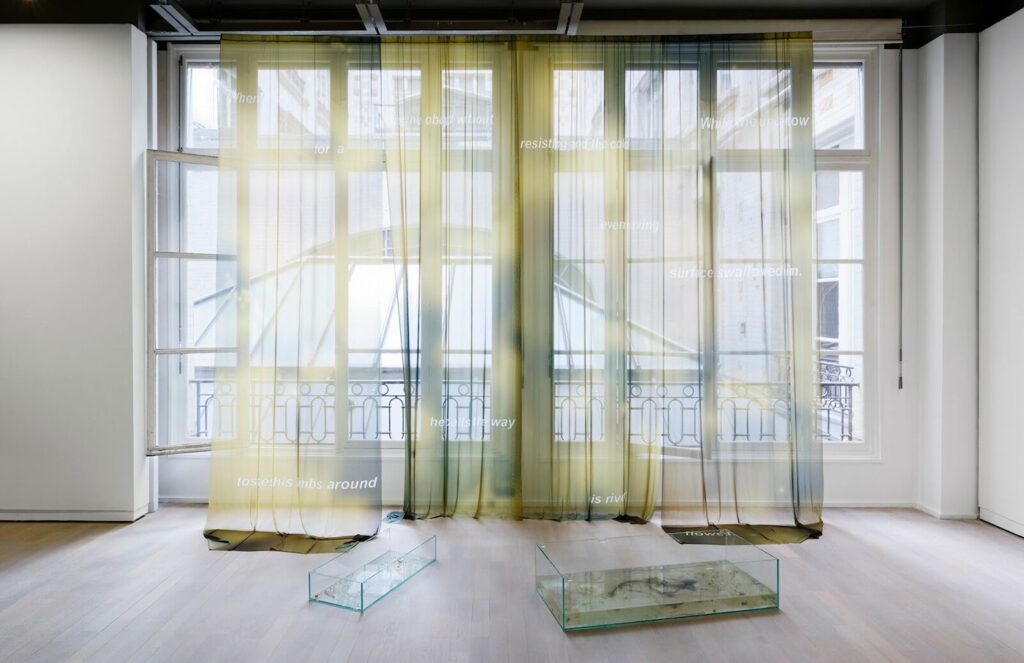Goodman Gallery, Cape Town, South Africa
28 Nov 2019 - 11 Jan 2020

Paul Maheke, The River asked for a Kiss and In The Watery Core of those Stories, 2017. Digitally printed curtains and fish tanks containing various aquatic non- indigenous species of plants, 145 x 410 cm. Courtesy the artist.
Goodman Gallery presents Soft Architectures, a group exhibition interrogating the intersection of architecture and structures of power and resistance.
Through sculpture, drawing, print, lens-based media and performance, the work of seven artists each explore the subtle and overt ways in which architecture has been implicated into forms of racialised surveillance, segregated accessibility and the discipline and comportment of bodies, and in turn how architecture has been subverted towards forms of resistance such as strategic concealment and networks of defiance.
Soft Architectures is realised across locations at Goodman Cape Town with many of the works themselves resisting and subverting the disciplinary constraints of the gallery space.
Artists include Yto Barrada (New York, USA), Kapwani Kiwanga (Paris, France), Simone Leigh (New York, USA), Mateo López (New York, USA), Paul Maheke (London, UK), Naama Tsabar (New York, USA) and Jeremy Wafer (Johannesburg, South Africa).
Kapwani Kiwanga’s research-based practice brings to light the materials used to entrench social, political and economic power structures as well as the artefacts used by those who have learned to circumnavigate these obstacles. Kiwanga’s recent body of work, Safe Passage, looks at systems which surveil and control individuals. Kiwanga connects these systems to a historic instance of surveillance used against black Americans from the time of slavery and the Jim Crow era to more modern technologies used to track citizens.
Yto Barrada similarly looks at strategies and gestures of survival and resistance in response to structures of power and control. Barrada unpacks the various ways in which authorities displace populations, raising questions of appropriation and authenticity. Barrada’s work creates structures of resistance through engaging alternative histories, highlighting the prevalence of fiction in hegemonic narratives.
Naama Tsabar uses everyday materials to realise experiential and conceptually-charged installations which question power, eroticism, gender and memory. In her most recent work, Tsabar invited female musicians to explore a new vocabulary of movement and sound through performances in which they insert their bodies between repurposed fragments of instruments juxtaposed alongside images where a female body penetrates and intertwines with walls.
Simone Leigh works across various disciplines including sculpture, video, performance and social projects which focus on race, history and gender. Leigh’s practice centres the black female experience and draws on African and African-American objects, ethnography, the history of architecture, feminist criticism and chronicles of political resistance. In so doing Leigh interrogates how material culture is categorised and historicised, as well as the anonymous, often invisibilised labour of women.
Jeremy Wafer’s practice variously explores colonial legacies. Working in a broadly post-minimalist sculptural idiom, Wafer’s sculptural installations investigate the notions and implications of location, boundaries, and constructed borders and the imprint of human architecture and it’s inherent and directed divisions and separations on the landscape.
Paul Maheke realises immersive installations through which he interrogates the potential of the body as an archive in order to address how history, memory and identity are formed and constituted. Incorporating installation, video, sound and performance, Maheke often plays with the interiority and exteriority of the gallery space in order to explore the tensions between hypervisibility and erasure.
Mateo López studied architecture for two years, before beginning his practice as an artist. In this work Lopéz challenges our perspectives of scale, dimension and functionality. Lopéz realises drawings and installations to describe autobiographical journeys, creating studio-like situations in which the production and display of the work intersect. In many cases, Lopéz combines real objects with drawings that he expands into three-dimensional forms, unfolding a narrative constructed by processes of associations rather than a linear trajectory.